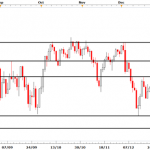
Remember when Bank of Canada Governor Poloz surprised the market with a second rate in early September? It caught the market off-guard as the market had priced in much less than a 50% chance of a hike.
Here is the chart of the BAX futures and CAD on the day Poloz shocked the market with the second unexpected hike.

Contrary to the Federal Reserve, which, in modern times, have never tightened when there was less than a 50% chance, the Canadian Bank Governor decided to teach the market a lesson. He purposely wanted to introduce some two-way risk into monetary policy. It was a return to Central Banking days of old. Poloz argued that in normal times, there was no need for extreme Central Bank hand holding. From Bloomberg reporter’s Luke Kawa:
The Bank of Canada has gone back to the future.
For the past decade, traders have been conditioned to expect central banks to both telegraph policy tweaks ahead of time and offer a thorough rationalization of those shifts at the time of implementation.
Canada’s central bank provided neither when hiking its benchmark rate to 1 percent on Sept. 6. Monetary policy makers hadn’t spoken publicly since July 12, when they delivered their first increase in almost seven years, nor was the latest decision followed by a press conference.
The data – which showed the Canadian economy expanded at a torrid pace of 4.5 percent in the second quarter, with core inflation measures beginning to edge higher – spoke loudly enough.
It’s a throwback to the way central bankers used to operate in the 1980s and 1990s, when policy shifts could be made on any business day, without warning. The Bank of Canada didn’t adopt fixed announcement dates until the new millennium.
“It’s bringing monetary policy back to what it was 20 years ago – no bells and whistles, just a decision and a statement,” said Christopher Ragan, associate professor of economics at McGill University and former special adviser at the bank.














Leave A Comment